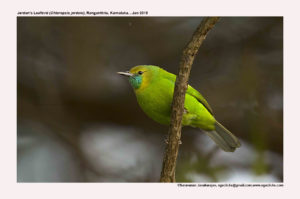
Jerdon’s Leafbird Chloropsis jerdoni
Etymology:
- Chloropsis: Greek word khlros – green; opsis-
- Jerdoni : Named after Scottish Ornithologist Thomas Claverhill Jerdon (1811–1872)
Distribution in India: Resident of Peninsular India.
Description:Size of 19-20 cm. The Male has black mask from lores back to eye and entire throat, enclosing large, long, intensely violet-blue jawline flash; rim around part of eye free of mask clear yellow, and yellow continues narrowly round margin of bib; cap and broad collar around bib brassy greenish-yellow; plumage otherwise bright grass-green, lighter below, relieved only by glossy turquoise lesser upper wing-coverts and straw-yellow distal outer webs of emarginated primaries; iris brown; bill black, or with grey base of lower mandible; feet slaty grey. The female is like male but lacks mask, has anterior cap olive-yellow and meeting viridian-tinged green at hind crown level, entire eyelid rim yellow, clean-cut bib turquoise (only slightly duller than jawline flash) and with same yellow border as male; otherwise as male.
Habitat: It is found in open forest, secondary growth, orchards, wooded gardens, coconut gardens, and wooded edges of roads, rivers, paddy land, and coffee, pepper vine etc. plantations; including deciduous vegetation. It favours relatively dry conditions, decreasing in numbers with rising general humidity.
Food Habits: It eats arthropods, fruits and nectar. Fruits include figs and berries; small fruit items eaten directly, but medium-sized, tough-coated items are pierced, and the contents then loosened and squeezed out by using the bill. It forages singly or as pair, and joins mixed-species hunting parties. Individuals may defend a nectar source pugnaciously.
Breeding Habits: They breed in Nov-May in India. They build a variable-depth open cup-nest that is compactly woven with materials like dry grass and soft fibers, with leaf and bark fragments added externally, and felted with cobweb, some silk running through the structure on to its support, with rudimentary lining. The nest is suspended at rim from prongs of thin outer fork at canopy level, typically in shade of overhanging foliage. They lay a clutch of 2 eggs,. The incubation period is 14 days and fledging period is 15 days.